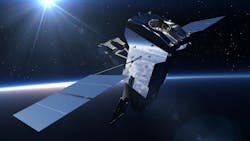Final Lockheed Satellite Joins Space Force
The sixth and final satellite in the U.S. Space Force’s missile-warning “constellation” has been launched, completing the $4.93-billion contract placed with Lockheed Martin in January 2021. The GEO-6 satellite joins five other Geosynchronous Earth Orbit (GEO) satellites in the Space Based Infrared System (SBIRS), a strategy to apply infrared surveillance as part of a missile-alert system for U.S. defense forces.
Said by Lockheed to be among the U.S.’s highest priority space programs, the SBIRS includes a combination of satellites and hosted payloads in geosynchronous earth orbit and highly elliptical orbit, as well as ground hardware and software.
The satellites’ onboard sensors collect data that help to detect missile launches, support ballistic missile defense, expand technical intelligence gathering and bolstering situational awareness on the battlefield.
"The need for Overhead Persistent Infrared (OPIR) systems has never been more critical," stated Michael Corriea, v.p. of Lockheed Martin Space's (OPIR) mission area. "At Lockheed Martin, we are making advancements to keep pace with evolving needs based on emerging threats in our military customers' environment, helping pave the way for the future."
The GEO satellite technology is based on Lockheed Martin's modernized LM 2100 Combat Bus™, which provides additional capabilities such as cyber hardening, resiliency features, enhanced spacecraft power, and improved propulsion and electronics.
According to Lockheed, the SBIRS GEO-6 satellite is responding to the U.S. Space Force's commands as planned. Signal acquisition was confirmed three hours and 43 minutes after the satellite's August 4 lift off aboard a United Launch Alliance (ULA) Atlas V rocket. The satellite is now orbiting under its own propulsion.
